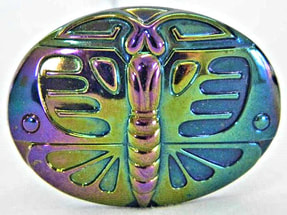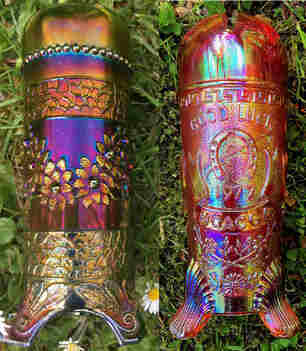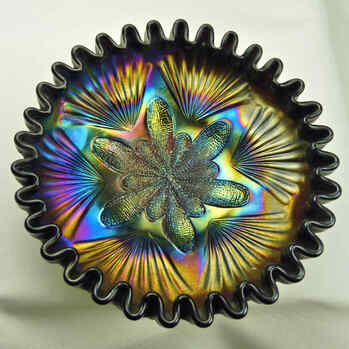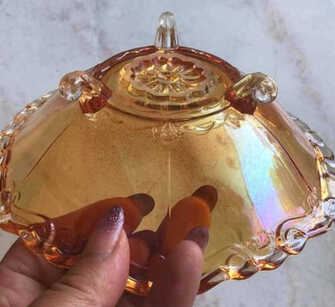NetworK ezine Issue 71. April 2021
Totally Devoted to Carnival Glass
|
A Jewel of a Story
In 2017 we published our ground-breaking research about the “discovery” and first use of iridescence on glass. We identified that the inventor of the process was Leo Valentin Pantocsek in Bohemia (covering parts of Czechoslovakia, Austria and Germany). Our NetworK readers were the first to know this information, which we featured in our October 2017 NetworK ezine, #29 and on our website, on the same date. Here’s where we first featured it: This was "breaking news" in 2017: Network Issue #29 And here is the full Story of Iridescence on Glass: Leo Valentin Pantocsek A couple of years before this (in 2015) we had written a series of feature articles on Carnival jewellery - beads, hatpins and buttons and more, and our subsequent work on the origins and location of iridescence on glass tied in with this. In our “Carnival Glass from Europe” Encyclopedia eBook we included a further supplement about this topic. It's sad to say that our research on Pantocsek and on Carnival jewellery has since been copied and passed off by others as their own work (without the professionally-accepted courtesy of asking permission or acknowledging the source). |
|
Carnival Jewellery – beads, buttons, hatpins and more
This genre is clearly very popular with collectors, as shown by the growing number of requests in our Facebook NetworK Group for more information about it. Building on our original research work and articles, we have authored an updated and expanded feature on this wide-ranging topic which is published in full on our website. Maybe it's not mainstream Carnival, but iridescent jewellery and fashion accessories (such as the Big Butterfly hatpin on the right) complement and enrich the fascinating story of Carnival and iridescent glass over more than a hundred years. It began in Bohemia
The production of beads, buttons and more, started in Bohemia, c.1800s, as a widespread cottage industry. During the early decades the industry was often plagued by strikes and labour riots, but later became more settled and commercialised. Today, iridescent buttons and beads continue to be produced for the fashion industry. |
|
Czech glass cottage workers, 1845. Gablonz Heritage Archive.
Many of the beads they made were iridised, making them especially attractive to the fashion industry. Vast quantities were exported to the USA and to other parts of Europe. On the right is a Montgomery Ward catalogue extract from 1895, which shows just how early iridescent beads were being imported into the USA. "Trimmings" were for sewing onto ladies’ clothing. |
A contemporary account of life in the Gablonz (Jablonec nad Nisou) area of Bohemia, during the early 1900s noted that “full of busy life was every home; the cottages often being of two rooms only, and with windows all closed against the sharp mountain air. The rooms over-heated, and serving as workshops, living rooms and bedrooms, and yet smart and clean. Here we saw them making women’s glass dress ornaments and glass trinkets.”
|
|
On the right is a selection of iridescent beads from the area: the oldest beads – green and blue – in the foreground, probably date from the early 1900s. Each strand holds hundreds of tiny glass cylinder-shaped beads. In the background are larger beads, from the 1950s and 1960s. The red ones are very unusual and hard to find. The availability of iridescent beads was advertised extensively from the early 20th Century (and indeed up to the present day). Our website article (link is at the end of this section) has lots of wonderful ads from around the world. Above: Lincoln Evening Journal, 1923 (Nebraska).
Below: even Baking Powder, beloved of "free" Carnival glass offers, got in on the carnival beads action! Here, in this New York newspaper ad also from 1923, a string of glass beads from Bohemia were offered free with purchases of baking powder. |
Iridescent beads on a conifer branch.
|
The Spangling Mania
It was the timeless allure of iridescence that made these beads so popular! A 1920s Winnipeg newspaper ad for iridescent beaded handbags / purses, such as the one shown on the right with a metal clasp and chain, described the enchantment perfectly:
It was the timeless allure of iridescence that made these beads so popular! A 1920s Winnipeg newspaper ad for iridescent beaded handbags / purses, such as the one shown on the right with a metal clasp and chain, described the enchantment perfectly:
|
“The designs on these bags show beautifully in the darkness. They are much sought after … owing to the delightful manner in which they enhance the appearance of the costume by the soft glow of their shining light”. It was all the rage, a hot trend, and the fashionable woman simply had to be seen wearing iridescent beads somewhere on her person. And there was even a name for it - the Spangling Mania. This quote from an 1896 London newspaper gives a wonderful impression of how the craze had spread. “The spangling mania is responsible for the over-elaboration of the ornamentation of many mantles, shoulder capes and yokes. When a woman begins to sew on wildly and indiscriminately, quantities of the little iridescent paillettes [that is the beads] that are to be bought in the trimming shop, she is apt to overdo the thing”. |
An illustration from 1911 “Toilettes” New York fashion journal featured two gowns covered with net spangled all over with iridescent glass beads.
|
|
There was no doubt about it - as well as the ever-popular iridescent hatpins and buttons, iridescent beads were to be seen everywhere. The fashionable woman in the early 1900s loved iridescence: not only did she have it in her home, on vases, tableware and more, but she also loved to wear it. Not just as beads around her neck, but in ways you would never imagine. On her dress, her hats, her handbags and even on her stockings!
Right: Iridescent stockings! A clip from the 1913 San Francisco Call newspaper. |
|
Iridescent buttons were also much sought-after fashion items, and used to accessorise women’s and girls’ outfits. You can see some of the old button moulds that were used to make these fascinating items, in our major article, “The Height of Fashion" (link below) Naturally, if you had hatpins, you would need something to hold them in safely ... and of course Carnival glassmakers very very happy to provide the solution - hatpin holders! On the left of the two shown here is a green Classic Carnival Orange Tree hatpin holder made by Fenton. On the right is a Contemporary Good Luck hatpin holder made in 1977 by L E Smith for the HOACGA club. Read the full and fully illustrated original story of Carnival Glass jewellery. Be fascinated by a wealth of archive material and newspaper ads covering this entire topic of beads, hatpins and buttons (and button moulds). The full story is here: The Height of Fashion There is also a lot of information about Carnival Glass, including jewellery and fashion items made in Europe in our comprehensive eBook: Carnival Glass from Europe Encyclopedia |
The detail is all revealed when the piece is turned over - shown here on the right. On the un-iridised exterior we see the Fenton logo in the centre, and etched around the marie we see:
Proof, 1/1 Levay, 4/05 2007 and finally Gary Levi’s signature. Tony went on to add “Fenton used several of his molds, especially in the days when they had an extensive relationship with the QVC network. Anyone who purchased a Fenton piece via QVC stood a decent chance it came from a Levay mold.” As well as being a unique item, this is an astonishing example of Fenton’s craftmanship in Contemporary Carnival. The extremely tight, continuous crimping is exceptional and clearly took much skill to execute. We have a whimsy Flowers of the World rose bowl (below, left) that was tightly crimped and folded in – in much the same way as the larger Persian Medallion piece was. |
Above and left, tightly crimped Persian Medallion whimsy, 2007. Courtesy Tony de Michael.
|
Whilst praising the skill of modern glassmakers at Fenton, we must also marvel at the legacy that was handed down to them from the makers of Classic Carnival, as demonstrated by the two wonderful examples of the tight continuous crimping technique used on Classic pieces sown above - in the centre is a green Fenton Ten Mums bowl, and on its right is a purple Dugan-Diamond Petal and Fan sauce.
Baroque Style
In January, this unusual marigold bowl was shown in our Facebook “Carnival NetworK” Group by Carmine Gianna Paolino. Here are her photos.
In January, this unusual marigold bowl was shown in our Facebook “Carnival NetworK” Group by Carmine Gianna Paolino. Here are her photos.
|
Janet Knechtel kindly stepped in and told us that she had an identical one that had a Westmoreland label – and that she had named it the “Knechtel Bowl”. We searched through Westmoreland catalogues that are available to us, but no sign of this fascinating bowl.
|
So, we turned to old Butler Bros catalogues … where we found a similar pattern (or at least a similar style) from Westmoreland - “Simplicity Scroll”.
|
Simplicity Scroll cigar holder and toothpick by Westmoreland. Courtesy Seeck Auctions.
|
This 1908 Butler Brothers ad shows Westmoreland Souvenirs – the covered boxes in the centre of the top row have the scroll design. Additionally, there are souvenirs and a dresser set in Westmoreland’s No. 238 pattern and also their No. 253, that also have baroque style scrolls around their edges.
|
To add more to the puzzle, here is another bowl which we show in our Carnival Glass from Europe Encyclopaedia, where we consider that it might possibly be a Walther item called Hexagonal Panels (but we are not sure), shown below. Look at the base and the scroll feet - they are so like Carmine's bowl and Janet's "Knechtel Bowl".
As yet, we have not found anything further – can anyone add more?
Una - Roger Peltonen’s Research
In our “Carnival Glass from Europe Encyclopedia” we show Eda’s Una pattern in the plate form, as featured in Eda’s 1929 catalogue. We also explained that what appears to be the same design is shown in Crown Crystal (Australia) catalogues in 1932 – called the “Eighty-Two Series” aka “Shell Panels”. Curiously, the Crown catalogue notes that the items were “not available until September 1935.
In our “Carnival Glass from Europe Encyclopedia” we show Eda’s Una pattern in the plate form, as featured in Eda’s 1929 catalogue. We also explained that what appears to be the same design is shown in Crown Crystal (Australia) catalogues in 1932 – called the “Eighty-Two Series” aka “Shell Panels”. Curiously, the Crown catalogue notes that the items were “not available until September 1935.
|
And now we have some exciting information and a new discovery, from glass researcher Roger Peltonen in Finland.
Roger tells us that he found this beautiful little blue Una creamer in Finland recently, and so he began to research its possible manufacturer. He takes up the story: “After I found the creamer, I tried to sort out the manufacturer. The pattern appears in Nuutajärvi catalog 1926 (plates) and Iittala catalog possibly as early as 1929 (plates and bowls). In 1932, Iittala bought molds from Eda (I have documentation of that) but exactly which molds is unknown. |
|
From a former employee at Iittala glassworks, I have received information that the sugar bowl and the creamer are included in a catalogue from 1934.
Iittala's production of pressed glass was transferred to Karhula in 1938 and in the Karhula-Iittala catalog and price list from 1939 there are plates, bowls and vases in this pattern, but not the sugar bowl and the creamer! Probably the production has been very short-lived and explains why these objects even in clear glass are very rare.” So, there we have the big picture – the wider story of this fascinating pattern – thanks to Roger’s research and information. This delightful blue creamer was made in Finland. |
1934 Iittala catalogue clip showing Una creamer and sugar,
courtesy Iittala Glass Museum. |
|
Solar/Feather Swirl and Athenia/Paneled 44
In our March issue of NetworK we featured a splendid ad for United States Glass items that was shown in a 1912 Foy & Gibson catalogue in Australia – and we originally noted that these two U.S. Glass patterns were not known in Carnival. But now we have more information. Feather Swirl, aka Solar: thanks to Joan Doty, who wrote to tell us that one of those patterns - Solar aka Feather Swirl - is known in Carnival. Here on the right is an extract from the 1912 U.S. Glass ad in the Foy & Gibson catalogue showing a large comport in the Solar pattern. Shown below (left), courtesy of Seeck Auctions, is a small green comport – lightly iridised – in the Solar aka Feather Swirl pattern. Note the scalloped foot, just like the larger sized comport shown in the catalogue. Below on the right, also lightly iridised - a marigold Solar, aka Feather Swirl butter dish and a swung vase (butter courtesy of Seeck Auctions, vase of courtesy of Burns Auctions). |
|
Smile!
Should a man dare to wear an iridescent suit before nightfall? Surely ... the question should be: "should anyone EVER dare to wear an iridescent suit? At the top of this issue, we explored the use of iridescence in fashion items, but on a suit! Even if it is the "Botany 500 Cosmos Iridescent Suit"! Nevertheless, the ad works hard to extoll its virtues - not only does it add verve, but it also provides "Sanitised Hygienic Freshness!" Source: Lodi News Sentinel, 1964. |
If you have missed any of the previous issues of NetworK and NetworK Specials, they are all here: Back Issues.
Privacy and the use of your information: we only use your name and email address to send you your FREE Carnival Glass NetworK ezine. We will not share your name or email address with anyone else, or use it for any other purpose. You can change your mind about receiving your NetworK ezine at any time by clicking the unsubscribe link at the foot of every issue, or by emailing us at [email protected]
Join us on Facebook
We would love you to come and join in the fun, and we invite you and your friends to join us all on NetworK's fast growing and very active Facebook Group!
We would love you to come and join in the fun, and we invite you and your friends to join us all on NetworK's fast growing and very active Facebook Group!




































